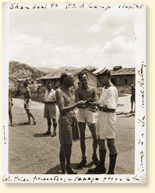

Liberation of Canadian prisoners at Shamshuipo Camp, Hong Kong, September 1945. |
The Canadian Armed Forces: Canadian Prisoners of the Axis Powers
8,995 members of Canada's armed forces became prisoners of the
enemy, and several hundred Canadian civilians too. Some fell into
enemy hands in several large groups. First were the 1,685 Canadians
of the Hong Kong garrison ( see Hong Kong, December 1941 ). 1,946
Canadians were captured by the Germans at Dieppe ( see Dieppe Raid, August
1942 ). A steady stream of aircrew, particularly from Bomber
Command, were taken into German camps. Undernourishment and boredom were the prisoners' great enemies. They
received the same type of rations as their captors. In Germany,
however, these rations became more and more inadequate over time and
in Japan, the portions and quality were always inadequate by western
standards. The Red Cross provided reading materials and sent
supplementary parcels of food but delivery of these was infrequent.
The Canadian Legion sent textbooks for those who wished to spend
their time learning new things. The German shot fifty Allied fliers, including six
Canadians, after a 1944 escape attempt. A significant number of
those taken prisoner in Normandy by the 12th Panzer ( Hitlerjugend )
were murdered. 260 of the Canadians taken at Hong
Kong died in Japanese prison camps, either in Hong Kong itself or in
Japan, from malnutrition, overwork, lack of medical attention or
brutality. Some Canadian aircrew were killed by the angry civilians
they had bombed, even before they could be taken as prisoners. Once the war was over, three Canadian Dieppe prisoners were charged
and convicted for their assistance to and collaboration with the
Germans. They served prison sentences. There were worries at home about prisoners in the deteriorating
conditions of 1945, but nearly all were liberated by the advancing
Allied armies, including the Russian Red , or freed themselves
when the enemy surrendered. Related Newspaper Articles
English Articles
- Prisoners of War (Photo and Caption)
The Hamilton Spectator, 18/02/1942
- Airman Killed In Escape Try
The Globe And Mail, 11/07/1942
- May Now Send Certain Foods To Prisoners
The Hamilton Spectator, 09/11/1942
- Canadians Are Taken To Reich
The Hamilton Spectator, 02/10/1943
- Women Share News of Men Who Are Prisoners of War
The Hamilton Spectator, 04/12/1943
- Returned Ace Says Allied Airmen Deliberately Shot
The Hamilton Spectator, 26/06/1944
- Allied Prisoners In Reich Moved As Reds Advance
The Hamilton Spectator, 13/02/1945
- 1064 Canucks Held in Prison In Jap Islands
The Globe And Mail, 31/08/1945
- Mirror's Flash Attracts Flyers To Enemy Camp
The Hamilton Spectator, 17/09/1945
- Report Most Recovered After HongKong Ordeal
The Globe And Mail, 03/12/1947
French Articles
-
Le sort de nos prisionniers
Le Devoir, 04/12/1941
-
Les prisonniers de Hong-Kong
Le Devoir, 13/01/1942
-
Le sort des soldats canadiens à Hong-Kong
Le Devoir, 08/01/1942
-
"L'affaire de Hong-Kong. 1,689 Canadiens prisonniers des Japonais"
Le Devoir, 26/02/1942
-
Le sergent Roger Rousseau prisonnier en Allemagne
Le Devoir, 11/04/1942
-
"2,000 Canadiens sont internés à Hong-Kong et à Kowloon"
Le Devoir, 30/04/1942
-
Le sergent-pilote Laurent Robillard de retour
Le Devoir, 05/05/1942
-
Canadiens détenus par les Japonais
Le Devoir, 04/08/1942
-
Les parents des prisonniers de guerre
Le Devoir, 26/08/1942
-
Lettres des prionniers de Hong-Kong
Le Devoir, 28/08/1942
-
Menace de représailles. Berlin menace de mettre les menottes aux soldats faits prisonniers à Dieppe...
Le Devoir, 02/09/1942
-
Les prisonniers de Hong-Kong. Ottawa publie une liste de 509 soldats et officiers canadiens
Le Devoir, 02/09/1942
-
"Le rationnement relâché en faveur des nôtres qui sont prisonniers de guerre"
Le Devoir, 11/01/1943
-
L'enchaînement des prisionniers
Le Devoir, 12/02/1943
-
Les prisonniers canadiens désenchaînés le 7 novembre
Le Devoir, 15/01/1943
-
Cadeaux au nom du Canada envoyés aux prisonniers
Le Devoir, 09/11/1943
-
Nouvelles de guerre. Le sort des nôtres prisonniers en Allemangne
Le Devoir, 15/09/1944
-
Lettre Ottawa. Colis et fournitures parvenus à Hong-Kong
Le Devoir, 16/09/1944
-
Message de M. King aux prisonniers de guerre
Le Devoir, 13/10/1944
-
259 autres militaires libérés. Liste des Canadiens français
Le Devoir, 15/05/1945
|